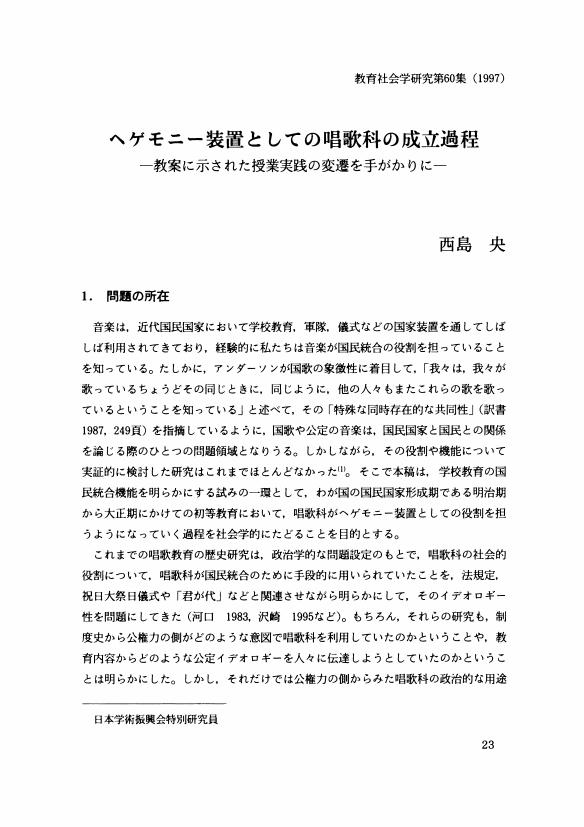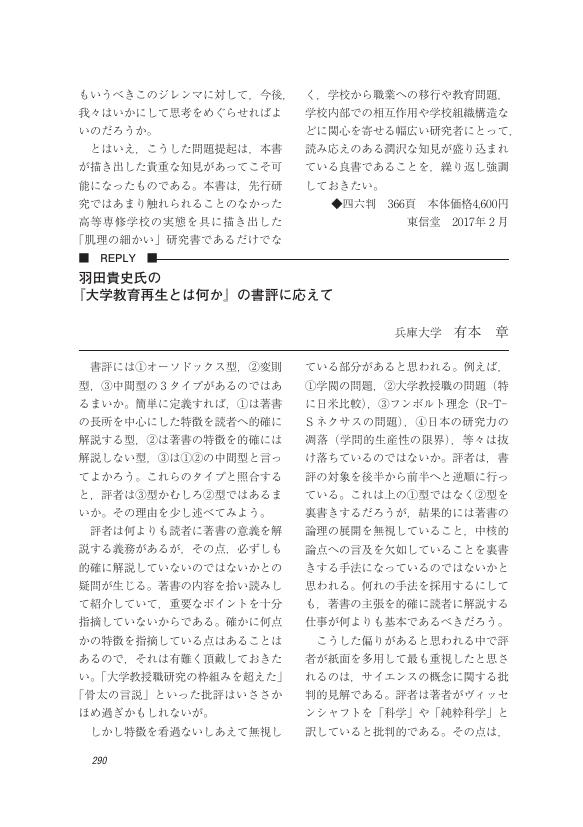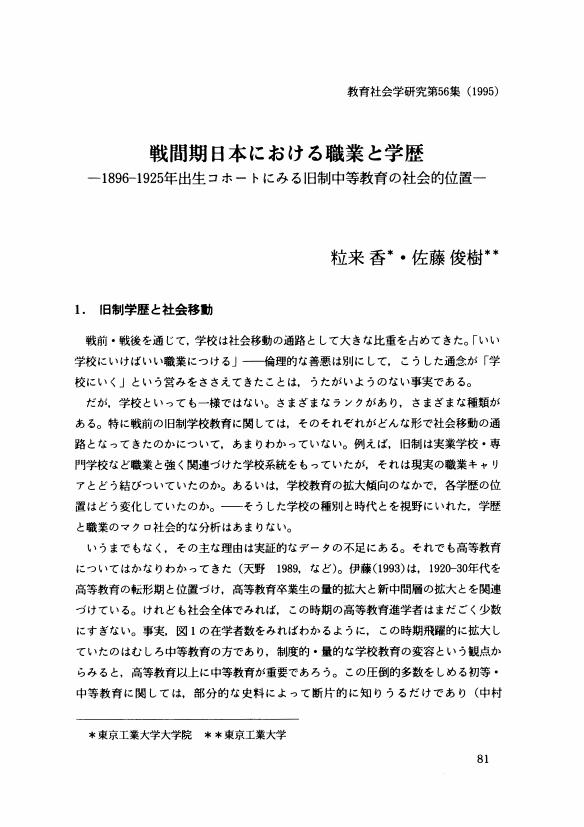1 0 0 0 90年代におけるカリキュラムと学力
- 著者
- 本田 由紀
- 出版者
- 日本教育社会学会
- 雑誌
- 教育社会学研究 (ISSN:03873145)
- 巻号頁・発行日
- vol.70, pp.105-123, 2002
- 被引用文献数
- 1
This paper aims to review the trends in the school curriculum and educational attainment in 1990s Japan. The first section outlines the curriculum policy. The 1987 Curriculum Council Report placed emphasis on a “Renewed View on Academic Achievement, ” while the amount of teaching time for each subject and the level of educational content was maintained. In contrast, the Curriculum Council Report in 1998 determined to drastically reduce teaching time and the content of subjects in anticipation of the start of the “five-day” school week system in 2002. At the same time it introduced a new “Time for Comprehensive Learning” into the school curriculum, the purpose of which is to cope simultaneously with the emerging social need for a variety of new knowledge and for renovated teaching methods. The reality of its actual implementation and its effects, however, remain uncertain and unforeseeable.<BR>The second section examines the debate on the “decline of educational attainment” which began at the end of the decade, and the actual situation of educational attainment. The proponents of this argument, which was triggered by data on the strikingly low level of mathematical ability among university students, shared their opposition to the recent curriculum policy of the Ministry of Education. As the result of this debate, not only did the Ministry shift its emphasis from the “Full Scope Education” to the improvement of educational attainment, but the social tendency of “bright -flight” to private schools has been accelerated. With regard to the actual situation of educational attainment, the available data imply that “in some cases it seems to be declining slightly.” A far more distinctive tendency is that the willingness of students to study is deteriorating, to differing extents according to their families' socio-economic status.<BR>The third section presents a theoretical hypothesis based on an examination of the two sections above. The decline of willingness to study among students reflects the end of the inter-system relation which was characterized by close links between the family system and the economic system via the educational system. On the other hand the educational system itself, as reflected in policies and discourses, maintains its conventional closed-ness and stiffness, the symptoms of which are the “institutionalization” of educational content and the abstracted interpretation of educational attainment. We conclude that it is crucial for the betterment of the educational system to break out of this closed-ness and to improve the relevance of educational content.
1 0 0 0 OA 戦後教育における学習可能性留保の構図 外国語教育を事例とした教育運動言説の分析
- 著者
- 相澤 真一
- 出版者
- 日本教育社会学会
- 雑誌
- 教育社会学研究 (ISSN:03873145)
- 巻号頁・発行日
- vol.76, pp.187-205, 2005-05-30 (Released:2011-03-18)
- 参考文献数
- 17
- 被引用文献数
- 2
This paper investigates the issues of students' ability to learn and the necessity for educational knowledge from 1957 to 1969, using the specific example of English teaching. With a special focus on discourse in the movement of the Japan Teachers Union, this paper examines the manner in which teachers dealt with these issues by constructing their own discourses and practices.Several points emerge from the analysis of educational movement discourses in English teaching. People, including educational participants, initially tended to believe that learning English served no purpose, and students found it extremely difficult to master the language. In the movement of the Japan Teachers Union, however, teachers indicated that the aim of learning English was not only to master the language but also to build the learner's character; therefore, it would be useful for all students to learn English. This idea is embodied in the “Four Goals, ” which seek the solidarity of nations and the deepening of students' understanding of their own languages rather than the acquisition of English. Consequently, two concrete attempts to attain these goals are notable. The first is independent practices by teachers to concretize the “Four Goals” that help build character. The second attempt is the discourse to redefine the ability to measure achievement in independent practice. The discourse on ability demonstrates that “true ability” is best measured not by the achievement tests given by the Ministry of Education but rather by a “zest for living.”In summary, focusing on the building of students' character rather than the mastery of learning materials led to a “solution” of the issues involving students' ability to learn and the need for educational knowledge in the discursive space alone. This form of “solution, ” through the analysis of discourse within the educational movement, is described as the “Japanese educational structure from the perspective of student's ability to learn.”
1 0 0 0 OA ヘゲモニー装置としての唱歌科の成立過程 教案に示された授業実践の変遷を手がかりに
- 著者
- 西島 央
- 出版者
- 日本教育社会学会
- 雑誌
- 教育社会学研究 (ISSN:03873145)
- 巻号頁・発行日
- vol.60, pp.23-42, 1997-05-15 (Released:2011-03-18)
- 参考文献数
- 37
1 0 0 0 OA 教育社会学における解釈的アプローチの新たな可能性 教育的言説と権力の分析に向けて
1 0 0 0 OA 羽田貴史氏の『大学教育再生とは何か』の書評に応えて
- 著者
- 有本 章
- 出版者
- 日本教育社会学会
- 雑誌
- 教育社会学研究 (ISSN:03873145)
- 巻号頁・発行日
- vol.102, pp.290-291, 2018-05-31 (Released:2020-03-13)
1 0 0 0 OA 生徒支援の教育社会学に向けて いじめ問題を中心として
- 著者
- 竹川 郁雄
- 出版者
- 日本教育社会学会
- 雑誌
- 教育社会学研究 (ISSN:03873145)
- 巻号頁・発行日
- vol.74, pp.77-91, 2004-05-20 (Released:2011-08-04)
- 参考文献数
- 29
- 被引用文献数
- 1
The purpose of this paper is to critically examine psycho-clinical guidance in thecontext of issues such as bullying and school non-attendance, and to consider theeffectiveness of the sociology of education for supporting students facing suchproblems. This study focuses on the problem of bullying. The author sets fivelevels for examining support for students in trouble, as follows. On the level ofthe individual, it is argued that the introduction of the school counselor aims toprovide support for students in trouble, but that a sociological perspective isrequired. On the level of personal relations and small groups, it is pointed outthat a student undergoing bullying in a subordinate position is in danger from asecret peer group, and may require emergency measures, such as a shelter. Onthe level of public groups, such as the classroom, it is argued that schoolcounselors and teachers cannot successfully deal with strategic grouping amongthe weak and the subtleties of bullying; consequently, the school system must bereformed through a process of trial and error. At the community level, theproblem of a closed society and the need to incorporate a sociological perspectiveinto support networks is cited. On the level of overall society, it is arguedthat more deliberate definitions and detailed knowledge of bullying still needs tobe pursued. On school non-attendance, the author argues that the creation of abetter learning environment and a career-planning system is important forschool non-attenders. Furthermore, it is argued that “Kokoro no Note” (Notesof the Heart) by the Ministry of Education, Culture, Sports, Science and Technologyare very problematical and need to be improved in order to expandstudent's insight into modern society. To cope with bullying and school nonattendance, support should be provided through both short-term urgent measuresand long-term developmental measures at all levels.
1 0 0 0 高校教育研究の展開:―学校格差構造から多様なリアリティへ―
1 0 0 0 OA わが国における「学級制」の成立と学級の実態の変化に関する研究
- 著者
- 濱名 陽子
- 出版者
- 日本教育社会学会
- 雑誌
- 教育社会学研究 (ISSN:03873145)
- 巻号頁・発行日
- vol.38, pp.146-157,en266, 1983-10-20 (Released:2011-03-18)
- 参考文献数
- 50
- 被引用文献数
- 1
The purpose of this paper is to examine how the “class system” of the elementary school in Japan has been formed, and according to which, to analize how the pupils' groupin the class and its educational function have changed. One way to measure the characteristics of the pupils' group is the homogeneity-heterogeneity of the pupils' age and their scholastic achievements and another way is the stability of the group. And it is supposed that the educational function of the class is constituted of the two dimensions; that is, the functionof instruction and the function of discipline.In the “grade system”, which was introduced in the beginning of the Meiji era, the pupils' group was homogeneous in scholastic achievements but heterogeneous in age, and the stability of the group was low.But, in the “one class system” after the institutionalization of the “class system” in 1891, the pupils' group became stable and heterogeneous in both age and scholastic achievements.In the 1900 s, the “school year class system” has spread. In this system, the pupils' group hasbecome homogeneous in age but heterogeneous in scholastic achievements. This system added the function of instruction to the function of discipline in the “one class system”, and the control of the teacher has become stronger.
1 0 0 0 OA ジェンダー・サブカルチャーのダイナミクス 女子高におけるエスノグラフィーをもとに
1 0 0 0 現代ハイティーンの社会的性格
- 著者
- 河合 慎吾
- 出版者
- 日本教育社会学会
- 雑誌
- 教育社会学研究 (ISSN:03873145)
- 巻号頁・発行日
- vol.16, pp.67-85,en250, 1961
Problem find Procedure <BR>The purpose of this study is to throw light upon the social character of modern highteens. The first point is to formulate their main characteristics by analyzing the data of the attitude survey of three highteen groups.(high school boys, young factory workers and white collar workers). The next point is to explore the conditions that injure their healthy development by using many documents about the highteen problems.<BR>Results Three characteristics of modern highteens are mainly as follows;<BR>(1) they have pluralistic ethical value systems, thatis, their values and ideologies are not monotheistical, (2) they assume rather ego-centric attitudes toward the society but they are the sametime, very sensitive to the judgement of their peer-groups, (3) they are practical and externally oriented, never confined themselves within the inner-worlds and enrich them.<BR>They have heathy personality traits in budding, but they are weak as individuals. So they cannot resist the negative forces without as individuals and are liable to surrender to the negative conditions, for example, over-competition in school and other seeming uncontrollable socio-political forces.
1 0 0 0 OA 高等専門学校教師の生態
- 著者
- 葉柳 正
- 出版者
- 日本教育社会学会
- 雑誌
- 教育社会学研究 (ISSN:03873145)
- 巻号頁・発行日
- vol.31, pp.95-105,en214, 1976-09-30 (Released:2011-03-18)
In this paper, the author tries to make clear what problems on teachers exist in technical college.We conducted several surveys: “The evaluation of the technical college system by teachers”, “Investigation on state of personnel changes” and “Analysis of the list of names”.The results of these studies can be summarized as follows:1) There are four groups on career pattern of technical college teachers: a group of college teachers' career, of high school teachers' career, of company employees' career and of the new graduates. Such diversity of career pattern is producing bad rather than good results in technical college. That is, the differences of those career patterns give rise to the split of opinion about educational points of view among technical college teachers.2) The system of interchange of teachers between institutions does not exist, so the proportion of personnel interchanges is only 3.2 per cent on an average in a year. An adequate method that facilitates the interchange of personnel among technical colleges, therefore, must be found out.3) Technical college teachers are carrying out the duties including those performed by high school teachers and even supervision of the dormitory. For that reason, they are put to the condition of overwork.4) Though technical college is categorized under higher education institutions, personnel administration is based on principal-centered system. Therefore, freedom of technical college teachers on the personnel problems is fairly restricted by principal power.5) The level of tecnical college teachers' salary has become lowest in all of the school systems since “The Law to Secure the Talented Person” became effective. Thus, many young teachers are strongly dissatisfied with the salary system in technical college.
1 0 0 0 韓国教育社会学研究の近年の動向と課題
- 著者
- キム ジョンウォン 崔佳英
- 出版者
- 日本教育社会学会
- 雑誌
- 教育社会学研究 (ISSN:03873145)
- 巻号頁・発行日
- vol.100, pp.12-19, 2017
1 0 0 0 OA 大学進学における所得格差と高等教育政策の可能性
- 著者
- 藤村 正司
- 出版者
- 日本教育社会学会
- 雑誌
- 教育社会学研究 (ISSN:03873145)
- 巻号頁・発行日
- vol.85, pp.27-48, 2009-11-30 (Released:2015-06-03)
- 参考文献数
- 31
- 被引用文献数
- 3 2
In a society like Japan, where half of students graduating from high school go on to college, there seems to be a universal belief that anyone who wishes to can gain access to college. In line with this, higher education policy has been directed toward increasing the quality of education. As a consequence, less attention seems to have been given to the ideal of equal opportunities for higher education. However, parental financial support for children has been pushed to the limit because of decreasing public finance and rising tuition at private universities.Yet there has been little systematic investigation of economic disparities in access to universities and the potential of equal opportunity policy. This article attempts to fill this gap. The 2005 National Students? Career Survey (NSCS) data set, which consists of the data from 4,000 high school seniors and their parents filled by random sampling, provides materials for examining these issues.We first estimated the marginal effect of the "achievement-income" dummy variables, high school rank, sex, and parent? s education on the probability of university attendance. Secondly, in order to examine the role of national universities, which are supposed to enroll students with "high academic achievement and low-income," we examined mobility patterns of application and admission among respondents as a function of city size, and university type (national/private). After examining the relationship between these patterns, we reported the results of the logit model to predict the marginal effect on four outcomes (national/private, home/away). We then investigated the effectiveness of scholarship loan programs (category 2 loans from JASSO, which bear interest) on the probability of university attendance. And finally, to clarify the reason not of "risk aversion" but of why parents go into debt, and to identify the latent group which applies for the loan program, a latent class analysis was used.The major findings are as follows: (1) Economic inequality in access to university education still exists after controlling other factors. (2) National universities guarantee post-secondary opportunities for students with "high academic achievement and low-income." (3) Student loan programs based on prior applications do not increase the accessibility of low-income students to colleges. These results show that, rather than loans themselves acting as an incentive, parents who have already intended to enroll their children into university apply for the loan program. (4) Parents who are willing to go into debt belong to a latent class, which are characterized as low-or middle-income, upward mobility.These findings show that the tight financial conditions facing higher education since the 1990s have changed the incentive structure by creating policies that give low-income families incentives comparable to those of higher-income families. Therefore, guaranteeing college opportunities for the low-income students, and extending opportunities for individual choice, are important problem for higher education policy.
- 著者
- 西村 幸満
- 出版者
- THE JAPAN SOCIETY OF EDUCATIONAL SOCIOLOGY
- 雑誌
- 教育社会学研究 (ISSN:03873145)
- 巻号頁・発行日
- vol.55, pp.107-125, 1994
1 0 0 0 OA 生徒の下位文化をめぐって
- 著者
- 武内 清
- 出版者
- 日本教育社会学会
- 雑誌
- 教育社会学研究 (ISSN:03873145)
- 巻号頁・発行日
- vol.27, pp.173-178, 1972-10-15 (Released:2011-03-18)
1 0 0 0 OA 台湾における教育社会学研究の歴史的回顧と発展状況
1 0 0 0 IR 教育とテクノロジー : 日本型EdTechの展開をどう捉えるか?
- 著者
- 井上 義和 藤村 達也
- 出版者
- 日本教育社会学会
- 雑誌
- 教育社会学研究 = The journal of educational sociology (ISSN:03873145)
- 巻号頁・発行日
- vol.107, pp.135-162, 2020
1 0 0 0 OA 「帰国生」の批判力と変革力 校則に関する議論を中心に
- 著者
- 渋谷 真樹
- 出版者
- 日本教育社会学会
- 雑誌
- 教育社会学研究 (ISSN:03873145)
- 巻号頁・発行日
- vol.66, pp.115-133, 2000-05-10 (Released:2011-03-18)
- 参考文献数
- 17
- 被引用文献数
- 1
Japanese school children who have spent some time living abroad before returning to Japan, who are known as “returnees, ” often experience a feeling of uneasiness at Japanese schools. This uneasiness, in theory, may be a potential catalyst for a review of accepted school routines and behaviour, as well as for improvement in such routines and behaviour. Based on fieldwork at a special class for “returnees” at one junior-high school, this paper explores how the students' questions and criticisms regarding school uniform rules were resolved.The “returnees, ” who were accustomed to the freedom that prevails at schools outside Japan, believed that school uniforms were a sign that Japanese schools were strict. At the time of the study, the school itself was undergoing an intense debate over the use of uniforms, and there were frequent discussions among students. The “returnees” rejected arguments in favour of a school uniform based on ideas such as “commonsense” and “junior-high schoolness, ” citing a diversity of values. On the other hand, they showed signs of self-regulation, using phrases such as “the way it is here” and surmising what they thought “regular students” would naturally take for granted. They believed that as newcomers to the school, they had a responsibility to follow prevailing customs. Despite the teachers' intention to encourage independent decision-making, the “returnees” felt that adapting their behaviour to fit in was the best way of getting along with “regular students.”Although the “returnees” had been exposed to other school environments, they did not have the confidence to initiate change in their existing environment. Instead they adapted themselves to the dominant regime, enabling them to avoid conflict and engage smoothly in educational activities. At the same time, they gave up the opportunity to exercise critical thinking and argue in favour of change. The “returnees'” tendency to accept the legitimacy of local customs implies a firm internalized conformation to norms, and highlights the crucial influence of unequal power relationships between “returnees, ” “regular students” and teachers. A more active pedagogy needs to be pursued if education is to encourage critical thinking and the ability to bring about change.
1 0 0 0 隣接分野から見た高等教育研究への問題提起
- 著者
- 相澤 真一 濱本 真一
- 出版者
- 日本教育社会学会
- 雑誌
- 教育社会学研究 (ISSN:03873145)
- 巻号頁・発行日
- vol.104, pp.147-167, 2019
<p> 本論では,高等教育研究を参照してきた隣接分野の立場から,教育社会学研究としての高等教育研究について,今後の研究への問題提起と期待を提示する。本研究が提示する高等教育研究の隣接分野とは,主に,中等教育研究と社会階層・社会階級・社会移動研究(以下,略して,階層移動研究)である。<br> それらの隣接分野の視点から見た場合,高等教育研究にはいくつかの課題が指摘できるように思われる。第1は,「日本の」高等教育の選抜を理解するために,その本質的な部分に関する定義を見直す必要があるのではないかということである。第2は,日本の高等教育制度は,社会階層構造に対して,どのような制度的文脈を持っており,どのような機能を保持しているかを明らかにすることが求められているという点である。第3は,高等教育研究ならではの視点である「高等教育機関が行う研究」を社会学的対象として配置していくことが必要となるという点である。<br> 以上の3点を踏まえて,日本の高等教育が制度的,歴史的に,世界のどのような類型に近く,どのような事例と比較されうるかを吟味することによって,より抽象度の高い階層移動研究に組み込んでいくことができると考えられる。また,日本の高等教育の特質を,隣接分野の文脈と共通性を持ちながら,より広い文脈を持った言葉で社会学的に明らかにしていくことにより,高等教育研究がより緊密に国際的な研究と結びついていくであろう</p>






